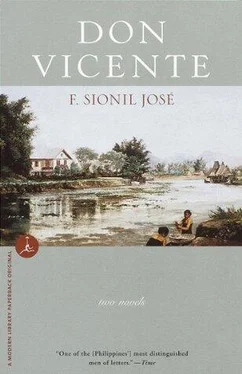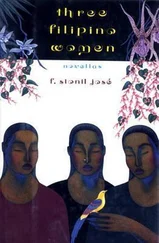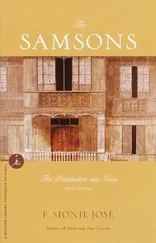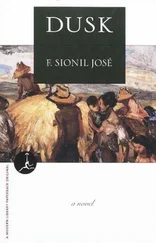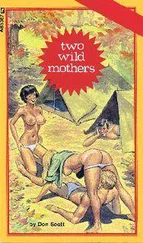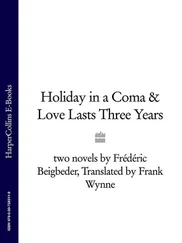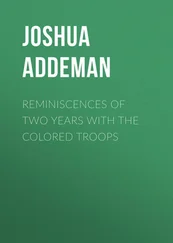The car picked up speed, and it was cool again. Luis returned to the manuscript he was reading.
“Do you really have to work?” Trining asked. “We are almost there.” Turning to her, Luis saw her pout; he had not been too attentive to her, so he placed the manuscript back and zippered the portfolio. She smiled and pressed his hand.
They were nearing Rosales — one more village and they would be there. To his right, beyond the clumps of bamboo on the horizon, the thin finger of the town’s yellow water tank towered above the trees, the coconut groves and the buri palms. The car slowed down as Simeon let a herd of carabaos cross. Then the car turned right to a dirt road, leaving the main cement highway.
Santos turned to Luis. “I might just as well tell you,” he said evenly. “Do not be alarmed when you see him and find him changed. We all grow old …”
Luis nodded.
“But in his case,” Santos continued, “he seems to have grown old suddenly — and tired. I am not saying he is different from what he has been in the last few months. But all day now he does nothing but stay in the house. He doesn’t go out anymore. Does not even read like he used to. He is just there, propped up on his bed with an ice bag on his head. The doctors say his heart is not getting any better, but he doesn’t believe them. He says it is the times, the mood. And at his age there is everything to make his heart worse. The troubles we are having in Lagasit, for instance. That’s why we now have civilian guards — twenty of them. You can never tell how useful they will be — in the north, particularly in Sipnget.”
“Sipnget? What is there?” Luis bent forward, anxious to know more.
Santos turned to him again, an assuring grin on his face. He seemed to know just what made Luis apprehensive. “Do not worry,” he said lightly. “Your grandfather and your mother, they are well. And your brother, Victor — I think he has found work.”
Luis leaned back, relieved.
“It’s another kind of trouble,” Santos elaborated. “You know about it, I am sure. You are working for a newspaper, and this is no secret anymore.”
“What is no secret?”
“Times are changing, Luis. People, too. The tenants are getting organized, and they cannot be frightened anymore — nor impressed by what is being done for them. The last time I was in Sipnget to supervise the division of the mongo harvest they were dissatisfied. All of them. One even said, ‘Well, the law says you only get a third of the harvest and we keep the rest. But you still get half. Remember, it isn’t far off when you won’t be able to get anything. In fact, it is you who will have to pay.’ ”
“You told Father this?”
“No, but I think he knows. And now, with all this bothering him, he is touchier every day.”
“You don’t have to tell me that,” Trining said, turning balefully to Luis. “Twice a month I go home. But you!”
“Please, it’s different with you,” Luis said.
“He reads your letters,” Simeon interrupted their private war, “and he gets your magazine and reads what you write. Sometimes he asks me to read for him. His eyes were never strong, and they are weaker now. But my knowledge of English is poor, and his eyeglasses — he breaks one almost every month.” Santos laughed nervously. “They are handy to throw when you are angry, you know.”
The ride was no longer comfortable, for the roadbed of pebble and stone, unleveled throughout the wet season, was laced with ridges, and where the pebbles had been scattered, the ruts were deep and the bigger boulders that were road foundations thrust up like mounds. The land had not changed — this vast brown land his father’s great-grandfather from that small pine-clad town in the Basque had claimed long ago in the name of the Spanish sovereign and the Asperris yet to come. On both sides of the road the fields, long shorn of their harvest, had become scraggly with growths of grass. Everything was tinted with brown and the dazzling sunlight, but beyond the fields, the foothills of Balungao, where his great-grandfather had once stood to gaze upon this plain — as his father never tired of retelling — were purplish and scabbed with black where the cogon grass had been burned. It was there that his father had gone in the past to hunt. It was to these foothills, gold-streaked and blue and bathed with translucent haze, that the farmers who could no longer farm in the plain eventually went to eke out a living from rock and thin soil.
The forest had long been shaved off, and where the deer and the wild boar used to roam, there remained only cogon wastes splintered into tenant farms for the hundreds of patient and land-hungry Ilokanos who had come down from their narrow and inhospitable homeland in the north. After three generations the footpaths had become roads leading to Acop, to Carmay, to Cabugawan, and to Sipnget and the small village called Rosales had become the center of the rice trade from the Cagayan Valley and had grown, as had the fortunes of the Asperris. They built bodegas , which they rented out to Chinese rice merchants and moneylenders. They also built a rice mill for the cheap grain their tenants produced and what they cornered in the harvest months, when the price of grain was very low. But difficult times soon came to the eastern portion of the province and to Rosales: a railroad to San Jose farther north cut down the importance of the town as a trading center. Left on its own, Rosales did not progress or produce more; there was no effort to build a dam across the two rain-fed creeks that hemmed the town and converged to drain the precious water into the Agno River. The Asperri clan did not manage the land well, and there finally came a time when only two were left — Don Vicente, who preferred the sybaritic pleasures of Manila and Europe, and Don Alfredo, his brother, who lived in the old brick house their grandfather had built. It was spared by revolutionary ire in 1898, but not by the colorums in the thirties.
Because Rosales is not astride the main Luzon highway, it is, like all small towns, condemned to anonymity and to that disquietude that has pervaded the rural areas for decades. The Ilokanos who inhabit it are hardy and given to carabao- like drudgery, but they are also in constant debt, not only to the Asperris but to the leaseholders, the encargados , and the Chinese shopkeepers or the lesser landlords, men like Santos who are Ilokanos, too.
Luis had not missed all this. The comforts of his Manila home had bothered him. It was in this Ermita house where his father had lived as an absentee landlord. It was here, too, where Luis had grown to manhood, away from the cares of Rosales and of Sipnget, away from his grandfather and his brother and his mother. Thinking of Sipnget now, Luis felt a dull ache pass through him, but it was nothing, nothing but a wisp in the wind; he was here in this place called Rosales — and how small, how nondescript and immemorial the town appeared.
It seemed as if in Rosales nothing had stirred from its ancient lethargy, as if no breath of life had blown through. Even the people in the streets, in front of nondescript stores, seemed to move about with the imprint of lassitude and surrender on their tired brown faces. Here was the herd, inured to everything; here was stone-hard patience not as virtue but as deadly vice — not only in the faces of people but in the physiognomy of the town itself, in the pathetic row of low, squat buildings with horrid soft-drink signs. The dirt road now had been asphalted as the center of the town has drawn near, with its main street and the town plaza — an expanse of withered grass, a cement basketball court with its cracked floor, and at one edge of the plaza this giant, gnarled balete tree, which, as small-town legends go, was supposed to be the home of spirits and all those anonymous wraiths that bode evil if they are not flattered with offerings. At the other end of the plaza was the municipio . It stood on the same spot where several years back, before the war, it was burned down. Fronting the municipio was the white monument of Rizal, stolid in the brilliant sunshine, and to its left was the Catholic church. The houses thinned out, and beyond was a line of small cogon-roofed houses on bamboo stilts and a few big houses of the merchants and lesser landlords.
Читать дальше
